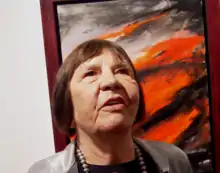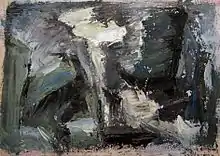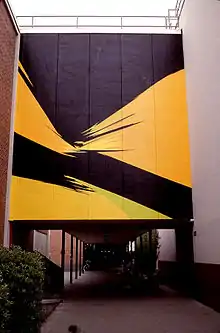Rita Letendre
Rita Letendre, CM OQ OOnt (born November 1, 1928 in Drummondville, Quebec) is a Canadian painter, muralist and printmaker associated with the Automatistes and the Plasticiens. She is an officer of the Order of Canada and a recipient of the Governor General’s Award.
Rita Letendre | |
|---|---|
 Rita Letendre in 2008 | |
| Born | November 1, 1928 |
| Education | École des Beaux-Arts, |
| Movement | Les Automatistes |
| Awards | Queen Elizabeth II Diamond Jubilee Medal; Governor General’s Award |
Early life
Rita Letendre was born the eldest of seven children to Anne-Marie Ledoux and Héliodore Letendre in Drummondville, Quebec. Despite her father working as a mechanic and obtaining trucking contracts when possible, life for them was difficult and the family lived in poverty.[1] Following a serious injury to one of her fingers in 1931, Letendre was sent to live with Marianna Ledoux, her maternal grandmother, in Saint-Francois-du-Lac.[1] There, she thrived in a more relaxed atmosphere where she could play, read, pick flowers, take boat rides and more importantly, escape her turbulent home life. The planned visit was to last for a year but continued until she was old enough to attend school.[1] At school, Rita was fascinated, this being her first opportunity to be stimulated intellectually.[2] In 1935, the family moved to Saint-Majorique-de-Grantham, near Drummondville, where integration to the community was difficult – here, she and her siblings (being of Abenaki heritage on their father’s side[3]) experienced the prejudices experienced by many First Nations children that were incessant and often violent.[1] Although she learned to defend herself well, she ultimately preferred solitude. To escape the hate that surrounded her, she created her own happier worlds, drawn in her schoolbooks.[2]
In 1941, the family moved back to Drummondville where she enrolled in her first year of high school but before she could return for a second year, the family moved to downtown Montreal[4] and Letendre had to stay home to take care of her five younger siblings while both of her parents took jobs for the war effort. This period of her life was a blessing in disguise; she continued drawing in the evenings, she was able to devour books as fast as she could get her hands on them, she discovered Opera on the radio which became a lifelong love, and she discovered famous master works of art in books at the library which she had heard about on the radio.[2] By 1946 she was desperate to escape her family duties; first taking a factory job, then working as a restaurant cashier, she left home to live with her boyfriend with whom she had a son, Jacques. It did not last and Rita separated from Jacques' father — Jacques was eventually raised by his maternal grandmother.[3]
École des Beaux-Arts




At age 19, while working at a restaurant in mid-town Montreal, a patron had seen some of the sketches she was working on when business became quiet and was struck by her talent.[5] Practically insisting she enrol in the École des Beaux-Arts (of which Letendre had never heard[5]), he picked her up at home, took her to the school and stood at the bottom of the steps ensuring she entered, then continued to stand there long enough for her to be asked if she was enrolling – the answer was "Yes".[2] After several questionnaires and a practical exam, she was accepted. It was there that she met friends Gilles Groulx, and Ulysse Comtois who was to be her boyfriend and partner for over 15 years. There she worked in a very academic atmosphere for a year and a half. In 1950 she went to view an art show "L’Exposition des Rebelles" (despite being largely condemned by her professors) and befriended the show organizer Jean-Paul Mousseau – this was her introduction to the circle of Borduas and the Automatistes.[2] Soon thereafter, she left l'Ecole des Beaux-Art.
The Automatistes
Paul-Émile Borduas (the main force behind the libertarian manifesto Refus Global) was probably the greatest influence to Rita’s life as a painter – he believed self-knowledge was the key to producing highly personal work.[5] Borduas was described by her as being "very nice, very intelligent, and very sensitive – he respected people". When she was mocked for painting figurative images, Borduas would defend her insisting figurative painting or non-figurative painting was still painting.[6] By 1951 Letendre had abandoned figuration and threw herself wholeheartedly into painting in abstraction. She began showing with the Automatistes in store windows and on fences in St-Louis Square in Montreal and lived mostly on beans and spaghetti.[1]
The Plasticiens
Her first official group show was in 1955 at the Henri Tranquille bookstore in Montreal alongside other first and second generation Automatistes. Eventually her work was noticed, most notably by artist/art critic Rodolphe de Repentigny (the major force behind the Plasticiens who espoused the philosophies of Piet Mondrian and the virtues of geometric form in art).[7] Impressed by the structure and form in the works of the Plasticiens, Letendre began changing her style to a more geometric one, employing more structured colour fields, zones of energy, thus temporarily abandoning the purely instinctual approach of Automatisme.[8] She showed at Espace 55 with the Plasticiens – the exhibition was shown in Quebec, Montréal, Rimouski and Toronto – the same year she had her first solo show at L’Echourie in Montreal.
Zen and Abstract Expressionism
In the late 1950s, having internalized the ideas of the Plasticiens, she abandoned the confines of geometric works and began studying the ideas of Zen and Confucius; these ideas began to translate into her paintings characterized by lines and strokes in black and white.[9] She was also struck by the work of the Abstract Expressionists in New York and in particular, impressed by the work of Franz Kline. Many of these elements and themes would be revisited in the works that soon followed, increasing in gestural quality and characterized with heavy impasto with a palette knife or spatula.[10] Her production began to increase and Letendre began to come into her own, winning first prize in the Concours de la Jeune Peinture in 1959 and the Prix Rodolphe-de-Repentigny in 1960. This prize (worth $300) and the additional sales that followed enabled Letendre to quit her job and paint full-time – it also allowed her to buy more paint and canvas than she dreamed possible.[11]
Armed with better paint, more colors and more material, she began painting larger works in explosions of violent color [12] and won second prize in the painting category in the Concours artistiques du Québec in 1961. Her compositions were intensely personal, more carefully planned; she began anchoring masses with carefully visualized gestures which would often take hours to visualize and execute.[9][13] Having secured a Canada Council grant in 1962, she travelled with Ulysse Comtois throughout Europe for the next year and a half. This was a productive period and she sent large groups of works home; the beginnings of her hard edge style also began, where more well defined masses or wedges would evoke vibration, movement and collisions.[10] In Italy she showed at Spolete, won a gold medal at Piccola Europa in Sassaferator, and met Russian-born sculptor Kosso Eloul.[2] On Eloul’s invitation to work in one of his studios, she travelled with Ulysse Comtois to paint in Israel.
Hard Edge
In 1964, her works became considerably simplified, more focused on geometric shapes and movement. She travelled to Paris for 3 months and ended her relationship with Ulysse Comtois; by the end of the year she was in a new relationship with Kosso Eloul. When he took a teaching position at California State College at Long Beach in March 1964, Letendre went with him. In California, two key opportunities availed her. The first was a commission to paint Sunforce a large mural executed on a campus building. Sunforce represents a critical turning point in her technique. In the context of California with its Light and Space Group, her impasto work may have seemed to make no sense.[14] Also, due to the massive scale of the mural, her current impasto technique was impractical and she was forced to adapt to the flat plane of the mural surface. In Sunforce, the image suggests a large mass that drops, and continues to drop as though it would continue through the bottom and off the painting.[9] The second, was the opportunity to learn printmaking, lithography and eventually silk screen, a technique conducive to hard-edge shapes.[15]
The couple left Los Angeles in 1969, alternating their time between New York and Toronto (which would continue until 1975)[16] and the demand for her work increased. In New York, galleries were purchasing entire series’ of 100 prints outright.[9] One day in 1971 someone suggested she might obtain a better effect on her long lines/rays if she used an airbrush; hesitant at first, she began using it more and more, then eventually used it all of the time. She found that airbrush brought her something new, something that neither oil, nor acrylic, nor the millions of lines she had made in the 1970s had succeeded in bringing her.[9] The popularity of her work continued with many public and private commissions for large scale works and murals including one covering the top six stories of the Neill-Wycik college residence at Ryerson University in Toronto, the first of its kind in Canada. She was also commissioned to design a huge coloured skylight for the ceiling of Glencairn (TTC) subway station in Toronto entitled Joy; it was eventually removed at Letendre’s request because the panels had faded after being exposed to many years of sunlight.[17]
In 1973, she began to soften some of the edges in her works,[15] a trend that would continue the next few years; this resulted in a myriad of horizontal landscape compositions often containing a few or even only one thin hard edge line.
Pastel
She began experimenting with pastels in 1980 and produced a remarkable series in 1982 inspired by the nearby Nevada landscape while staying with her husband in Beverly Hills as he recovered from heart surgery.[18] Pastels and the techniques she developed with them afforded her an opportunity to create a soft edge effect in landscape like compositions using a completely different medium.
Reversion to oil and current work
By 1995 she worked in heavier oils again, abandoning the airbrush completely, and controlled her gestural compositions with brush, palette knife and her bare hands. Her husband, Kosso Eloul, died later that year, and she took a long break from painting.[19] In the summer of 1997 she returned to painting and continued to show and develop her style. After having sold her house in Toronto, she moved back to Montreal in 2004. She went on to be awarded the Order of Canada in 2005, an honorary Ph.D. from the University of Montreal and the Governor General’s Award in 2010 and the Queen Elizabeth II Diamond Jubilee Medal in 2012. At 87, Letendre has continued to produce and show works created as recently as 2014. In 2017 her work was included in the exhibition, The Ornament of a House: Fifty Years of Collecting at the Burnaby Art Gallery[20] Her work also appeared in an exhibition at the Art Gallery of Ontario in 2017, Fire and Ice, which was said to be long overdue.[21]
Awards
- 2016 – Member of the Order of Ontario[22]
- 2012 – Recipient of the Queen Elizabeth II Diamond Jubilee Medal
- 2010 – Honoris Causa Ph D – University of Montreal
- 2010 - Governor General’s Award in Visual and Media Arts
- 2010 - Creation of prix hommage Rita-Letendre de la ville de Drummondville
- 2005 - Officer of the Order of Canada
- 2002 - Officer of l'Ordre National du Québec
- 1975 - Canada Council Senior Arts Grant
- 1970 - Ile Festival International de Peinture, Cagnes-sur-Mer, France (Prix National)
- 1967 - Bourse de Recherche, Gouvernement du Québec
- 1962 - Gold Medal, Piccola Europa Exhibition, Sassoferrato, Italy
- 1962 - Canada Council Travel Grant (Europe)
- 1961 - Prix de la Peinture, Province du Québec
- 1960 - Prix Rodolphe-de-Repentigny
- 1959 – Premier Prix, Concours de la Jeune Peinture
Solo shows
Rita Letendre has had many solo shows, among them, the following:
- 2017 Rita Letendre: Fire & Light, Art Gallery of Ontario, Toronto[23]
- 2005 Rita Letendre: Beginnings in Abstraction, Robert McLaughlin Gallery, Oshawa, Ontario
- 2004 Musée du Québec
- 2004 Winnipeg Art Gallery
- 2003 Musée du Québec
- 2001 Centre d’Exposition de Baie-Saint-Paul, Québec
- 1999 Art Gallery of Algoma, Sault Ste. Marie
- 1998 Centre Culturel de Drummondville
- 1993 Blackwood Gallery, University of Toronto
- 1990 Robert McLaughlin Gallery, Oshawa, Ontario
- 1989 Concordia Art Gallery
- 1983 Gallery Graphica, Edmonton
- 1980 Centre Culturel de Drummondville
- 1979 The Art Package, Chicago
- 1976 Algoma Festival of Technical Arts, Sault Ste. Marie
- 1976 Arras Gallery, New York
- 1975 Vibrations Coloreés, Place des Arts, Montreal
- 1974 Palm Springs Desert Museum, Palm Springs, California
- 1973 Benson Gallery, New York
- 1973 University of Toronto, School of Architecture
- 1972 Museé d’Art Contemporain, Montreal
- 1972 The Arwin Gallery, Detroit
- 1969 Gordon Gallery, Tel-Aviv, Israel
- 1963 Dorothy Cameron Gallery, Toronto
- 1963 University of Ottawa Art Gallery
- 1963 Université of Sherbrooke
- 1962 Here and Now Gallery, Toronto
- 1961 Dorothy Cameron Gallery, Toronto
- 1961 Galerie Denyse Delrue, Montreal
- 1961 Here and Now Gallery, Toronto
- 1961 Museé des Beaux-Arts, Montreal
- 1959 Galerie Denyse Delrue, Montreal
- 1958 Galerie Artek, Montreal
- 1956 Galerie L’Actuelle, Montreal
- 1955 Galerie L’Echourie, Montreal
Major collections
- National Gallery of Canada, Ottawa
- Musée d’Art Contemporain, Montreal
- Musée des Beaux-Arts, Montreal
- Musée National du Québec, Québec
- Musée Laurier
- Concordia Art Gallery, Montreal
- Vancouver Art Gallery
- Art Gallery of Windsor
- Carleton University Art Gallery, Ottawa
- Art Gallery of Ontario, Toronto
- Canada Council Art Bank, Ottawa
- The Palm Springs Desert Museum Palm Springs, California
- San Diego Art Gallery
- The Robert McLaughlin Gallery, Oshawa, Ontario
- Storm King Art Center, New York
- Ministry of External Affairs
- Speed Museum, KY
- University of California, Long Beach
- Long Beach Museum of Fine Arts
- Moncton University, NB
- City of Burnaby Permanent Art Collection[24]
References
- Letendre, Rita. "Portrait of the artist as a damn good painter". archive.macleans.ca. Maclean`s, 1975. Retrieved 2020-08-12.
- Ninacs, Anne-Marie. "Rita Letendre : Aux couleurs du jour". Musée national des beaux-arts du Québec. Retrieved 2020-08-12.
- Roberge, Gaston. "Rita Letendre: Woman of Light". Belle, 1997. Retrieved 2020-08-12.
- Paikowski 1989, p. title.
- Jansma 2005, p. 2.
- “More than meets the eye: Rita Letendre can tell you where the partridge is”, Quest, John Lownsbrough, 1982
- ”Manifeste des Plasticiens”, Repentigny et al.,1955
- Lowndes, Joan. "Rita Letendre Has Made it Her Own". www.newspapers.com. Vancouver Sun, April 12, 1976, p. 19. Retrieved 2020-08-14.
- Hazelgrove 1995, p. 5-6.
- Jansma 2005, p. 5.
- “More than meets the eye: Rita Letendre can tell you where the partridge is”, Quest, John Lownsbrough, 1982
- “Rita Letendre – Sous la Ligne du Feu”, Jean Sarrazin, Le Nouveau Journal 1961
- "World of Art - Letendre”, Robert Fulford, Toronto Star, March 24, 1962
- Jansma 2005, p. 6.
- Ellenwood, Ray. "The Trajectory of Rita Letendre" (PDF). rayellenwood.files.wordpress.com. Gallery Gevik, 2010. Retrieved 2020-08-12.
- Gagnon, Claude-Lyse. "Rita Letendre". /www.erudit.org. Vie des Arts 1969 (57), 57. Retrieved 2020-08-12.
- McIlveen, Eli. "Art on the TTC". transittoronto.ca. Transit Toronto, 2010. Retrieved 2020-08-12.
- Sabbath, Lawrence. "Local Scene Bustling with Exciting, Innovative Exhibits". www.newspapers.com. The Gazette, June 23, 1982, p. 23. Retrieved 2020-08-13.
- ”Rita Letendre’s Paintings Take You to a Higher Elevation”, Bernard Mendelman, The Suburban, 1997.
- Cane, Jennifer, Ellen van Eijnsbergen (2017). The Ornament of a House: Fifty Years of Collecting. Burnaby: Burnaby Art Gallery. pp. 58–59. ISBN 9781927364239.
- Fulford, Robert. "Canadian artist Rita Letendre upstages O'Keeffe at long-overdue AGO exhibition". nationalpost.com. National Post, July 7, 2017. Retrieved 2020-08-13.
- "New Appointees to the Order of Ontario". January 13, 2016.
- "Rita Letendre: Fire & Light". Art Gallery of Ontario. Retrieved 20 July 2017.
- "City of Burnaby Permanent Collection".
Bibliography
- Nasgaard, Roald (2008). Abstract Painting in Canada. Douglas & McIntyre. p. 180. ISBN 9781553653943. Retrieved 2020-08-11.
- Jansma, Linda (2005). Beginnings in Abstraction. Oshawa: Robert McLaughlin Gallery. Retrieved 2020-08-12.
- Hazelgrove, Nancy (Winter 1995). A Line has Two Sides. Toronto: Artword. pp. 5–6.
- Paikowski, Sandra (1989). Rita Letendre: The Montreal Years. Montreal: Concordia University. p. 18. Retrieved 2020-08-12.